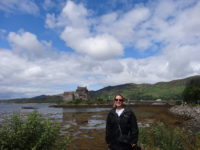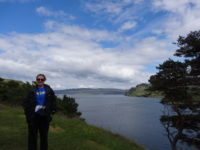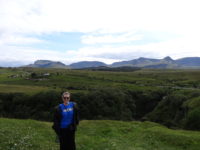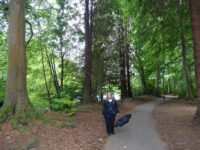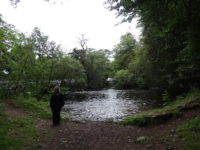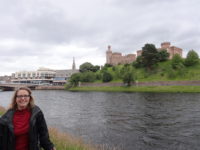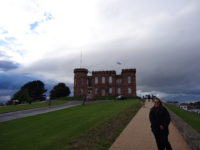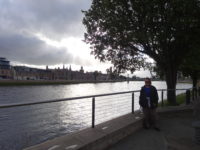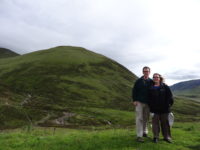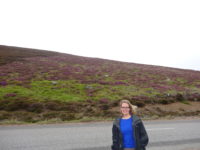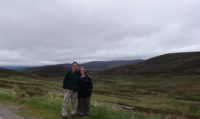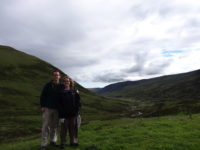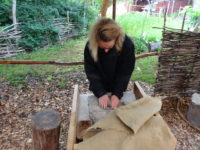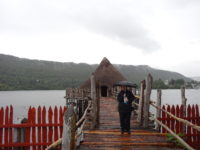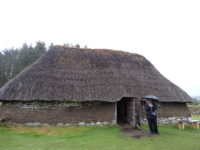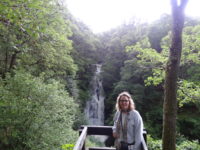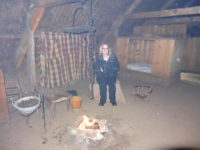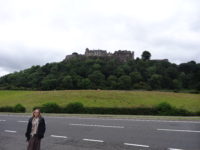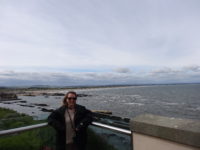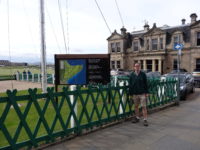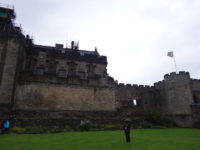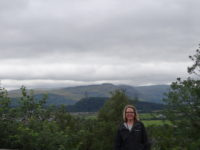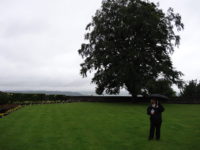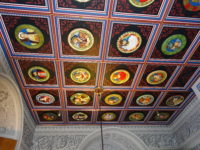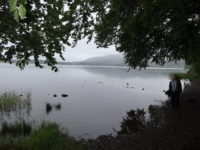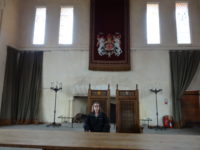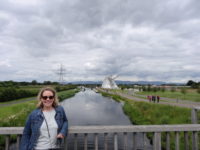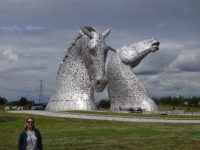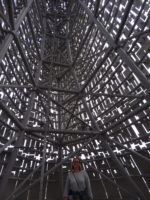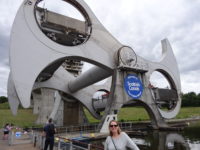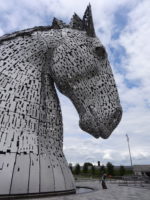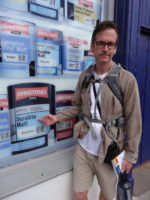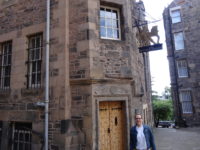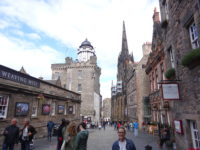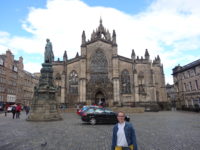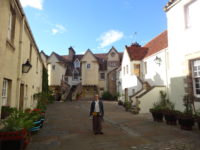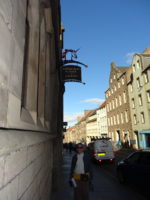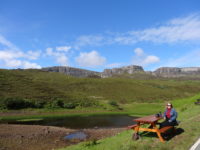 I decided to continue the guidebook-recommended northern loop of the Trotternish Peninsula, since our hostess also recommended it. Much of the initial driving was on a single-lane road, but there were plenty of pull-offs, so that was never an issue. I think I got out less than five miles before we pulled off to look around at the mountains. It was also very quiet. Apart from the bleats of the sheep in front of us and the very occasional car going by, there was nothing to hear. It was very peaceful, and we stayed there for about ten minutes, watching sheep and enjoying the sunshine.
I decided to continue the guidebook-recommended northern loop of the Trotternish Peninsula, since our hostess also recommended it. Much of the initial driving was on a single-lane road, but there were plenty of pull-offs, so that was never an issue. I think I got out less than five miles before we pulled off to look around at the mountains. It was also very quiet. Apart from the bleats of the sheep in front of us and the very occasional car going by, there was nothing to hear. It was very peaceful, and we stayed there for about ten minutes, watching sheep and enjoying the sunshine.
We continued around the drive, stopping once more by the ocean where a cliff towered over the road. Again, it was quiet, and we stayed for five or ten minutes, before heading over to the Skye Museum of Island Life, a little museum of seven thatched cottages depicting how people of Skye lived in the late 1800s and early 1900s. Again, as we have seen several times on this trip, life was hard and not all that different from over one thousand years ago.
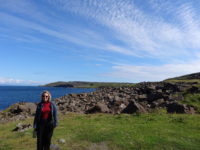 The museum had one “big” house where the parents and ten children lived in three rooms. This house was actively lived in until 1954. There was a small barn, used to keep the milk cow warm during the winter, a weaver’s hut, a blacksmith’s hut, a social/music house, a general store, and a couple of other buildings. Many of the houses had lots of information about the people of island, including religion, farming, fishing, and such. Fishermen were very superstitious people, thinking it bad luck to see a woman, a minister, or a redheaded person before going out to fish. The farming (“crofting”) was incredibly hard work where the ground was often too rugged to be worked by horses, and where it could be worked by horses, the tenants usually could not afford a horse. Meredith’s summary of the exhibit was, “We are soft.” That is about right. Oh, and Mer’s Scottish roots showed up in an older picture of a woman weaving a basket: the woman looked exactly like Mer’s mom did when she was young. It was eerie.
The museum had one “big” house where the parents and ten children lived in three rooms. This house was actively lived in until 1954. There was a small barn, used to keep the milk cow warm during the winter, a weaver’s hut, a blacksmith’s hut, a social/music house, a general store, and a couple of other buildings. Many of the houses had lots of information about the people of island, including religion, farming, fishing, and such. Fishermen were very superstitious people, thinking it bad luck to see a woman, a minister, or a redheaded person before going out to fish. The farming (“crofting”) was incredibly hard work where the ground was often too rugged to be worked by horses, and where it could be worked by horses, the tenants usually could not afford a horse. Meredith’s summary of the exhibit was, “We are soft.” That is about right. Oh, and Mer’s Scottish roots showed up in an older picture of a woman weaving a basket: the woman looked exactly like Mer’s mom did when she was young. It was eerie.
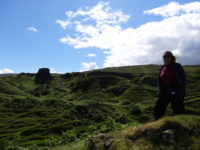 Up behind the museum was a cemetery, and we like touring cemeteries in beautiful places, and this one had a famous monument in it – to Flora MacDonald, who helped Bonnie Price Charlie escape from the government after his defeat at Culloden. Her grave is marked by a huge Celtic cross, which was interesting, but there were lots of other graves too, of course. One interesting feature was that many of the gravestones mentioned first-person perspective – “my mother” or “our parents” – and the stone usually mentioned who put it up in addition to whom it memorialized.
Up behind the museum was a cemetery, and we like touring cemeteries in beautiful places, and this one had a famous monument in it – to Flora MacDonald, who helped Bonnie Price Charlie escape from the government after his defeat at Culloden. Her grave is marked by a huge Celtic cross, which was interesting, but there were lots of other graves too, of course. One interesting feature was that many of the gravestones mentioned first-person perspective – “my mother” or “our parents” – and the stone usually mentioned who put it up in addition to whom it memorialized.
Next stop was the Fairy Glen near Sheadar, which was wonderfully bizarre. Mer had wondered if we would know when we got to the Glen. It was pretty obvious. One minute we were in beautiful Skye countryside, and the next we were in a world where you could see the possibility of fairies living here. There were dozens of conical mounds, traversed by sheep paths, which gave each “hill” a terraced effect. We got out and hiked over several of the fairy towers; we had never seen anything quite like them before. We passed on attempting to climb the largest one, the top of which looked to be very difficult to reach. We had a good time, but did not see any fairies.
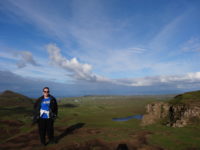 That ended the scenic loop, but on the recommendation of our hostess, we drove over to Dunvegan, to Dunvegan Castle, which has been continuously lived in for over eight hundred years. We got a very late (3:00) lunch at the cafe, and then we wandered the gardens. I was car-weary, and a little tired of touring buildings, so a quiet walk in pretty gardens was perfect. We spent about an hour in the various sections of the grounds. The castle is well situated on the sea with hills and mountains about.
That ended the scenic loop, but on the recommendation of our hostess, we drove over to Dunvegan, to Dunvegan Castle, which has been continuously lived in for over eight hundred years. We got a very late (3:00) lunch at the cafe, and then we wandered the gardens. I was car-weary, and a little tired of touring buildings, so a quiet walk in pretty gardens was perfect. We spent about an hour in the various sections of the grounds. The castle is well situated on the sea with hills and mountains about.
I decided we had time to drive to the southern part of the island, to the beginning of the Cuillin Hills, which are pretty much mountains. They are difficult to hike and can be dangerous, since they are steep and remote, but there is one hike that is easy and fairly safe, and stayed with our earlier theme – we hiked the thirty-minute Fairy Pool Trail. That walks you right up to the Cuillin Hills, and does so on mostly flat ground. You also get to walk next to a small river that has several waterfalls and pools. We hiked up to near the top of the pools, and we just sat there for about half an hour. I dipped my foot in the water, and it was not so cold as I’d expected – by no means bath water, but it did not make my foot hurt. The sound of the water was soothing, and the looming hills were very impressive. This is probably my favorite spot in Scotland to date.
 We walked back to the car and drove the thirty minutes to Portree, where we got supper. We also got take-out dessert to eat on a bench back at the B and B, looking out to sea with the mountains to our left and the Outer Hebrides on the horizon. This is the kind of day that can spoil you.
We walked back to the car and drove the thirty minutes to Portree, where we got supper. We also got take-out dessert to eat on a bench back at the B and B, looking out to sea with the mountains to our left and the Outer Hebrides on the horizon. This is the kind of day that can spoil you.

